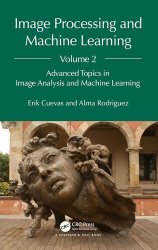Image Processing and Machine Learning, Volume 2: Advanced Topics in Image Analysis and Machine Learning
- Добавил: literator
- Дата: 3-01-2024, 09:03
- Комментариев: 0
 Название: Image Processing and Machine Learning, Volume 2: Advanced Topics in Image Analysis and Machine Learning
Название: Image Processing and Machine Learning, Volume 2: Advanced Topics in Image Analysis and Machine LearningАвтор: Erik Cuevas, Alma Nayeli Rodríguez
Издательство: CRC Press
Год: 2024
Страниц: 239
Язык: английский
Формат: pdf (true)
Размер: 31.6 MB
Image processing and Machine Learning are used in conjunction to analyze and understand images. Where image processing is used to pre-process images using techniques such as filtering, segmentation, and feature extraction, Machine Learning algorithms are used to interpret the processed data through classification, clustering, and object detection. This book serves as a textbook for students and instructors of image processing, covering the theoretical foundations and practical applications of some of the most prevalent image processing methods and approaches.
Divided into two volumes, this second installment explores the more advanced concepts and techniques in image processing, including morphological filters, color image processing, image matching, feature-based segmentation utilizing the mean shift algorithm, and the application of singular value decomposition for image compression. This second volume also incorporates several important Machine Learning techniques applied to image processing, building on the foundational knowledge introduced in Volume 1.
Machine Learning (ML) is a branch of artificial intelligence (AI) that enables systems to learn from data and make informed predictions or decisions without the need for explicit programming. ML finds extensive applications in various domains. For instance, in automation, ML algorithms can automate tasks that would otherwise rely on human intervention, thereby reducing errors and enhancing overall efficiency. Predictive analytics is another area where ML plays a crucial role. By analyzing vast datasets, ML models can detect patterns and make predictions, facilitating applications such as stock market analysis, fraud detection, and customer behavior analysis. ML also aids in decision-making processes, as its algorithms provide valuable insights and recommendations based on data, helping organizations make more informed and optimal decisions. Overall, ML is a powerful field within AI that offers immense potential for automating tasks, generating predictions, and supporting decision-making processes across various domains.
The integration of image processing and ML involves the utilization of techniques from both domains to analyze and comprehend images. Image processing techniques, including filtering, segmentation, and feature extraction, are employed to preprocess the images. Subsequently, ML algorithms come into play to analyze and interpret the processed data through tasks such as classification, clustering, and object detection. The ultimate objective is to harness the strengths of each field in order to construct computer vision systems capable of autonomously understanding and analyzing images without human intervention. This fusion allows image processing techniques to enhance image quality, thereby improving the performance of ML algorithms. Simultaneously, ML algorithms automate the analysis and interpretation of images, thereby reducing the reliance on manual intervention. By combining these two fields, a powerful synergy is achieved, enabling the development of robust and efficient systems for image analysis and understanding.
While other comparable books often prioritize the theoretical aspect of the subject or provide a general approach to algorithm development, our book takes a different approach based on our teaching experience. We have observed that students grasp the material more effectively when they have access to code that they can manipulate and experiment with. In line with this, our book utilizes MATLAB as the programming language for implementing the systems. MATLAB is widely popular among engineers and offers an extensive library collection for various disciplines. Although other programming languages like Java, R, C++, and Python are also utilized in engineering, MATLAB stands out due to its unique features and the familiarity it holds among practitioners in the field. By employing MATLAB, we aim to provide readers with a practical and hands-on experience, enabling them to modify and explore the code, further enhancing their understanding of the concepts and fostering their ability to apply the techniques in real-world scenarios.
Written with instructors and students of image processing in mind, this book’s intuitive organization also contains appeal for app developers and engineers.
Скачать Image Processing and Machine Learning, Volume 2: Advanced Topics in Image Analysis and Machine Learning
Внимание
Уважаемый посетитель, Вы зашли на сайт как незарегистрированный пользователь.
Мы рекомендуем Вам зарегистрироваться либо войти на сайт под своим именем.
Уважаемый посетитель, Вы зашли на сайт как незарегистрированный пользователь.
Мы рекомендуем Вам зарегистрироваться либо войти на сайт под своим именем.
Информация
Посетители, находящиеся в группе Гости, не могут оставлять комментарии к данной публикации.
Посетители, находящиеся в группе Гости, не могут оставлять комментарии к данной публикации.
